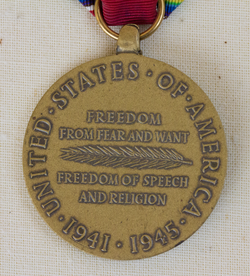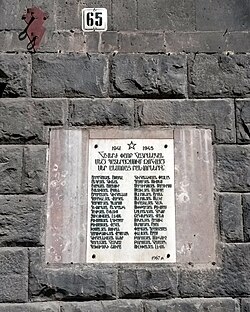
Have you discovered your World War II veteran’s story? If not, I have two words for you – Start Today! Firsthand accounts of any event are invaluable, and our WWII veterans are a priceless resource. Any still alive will be upwards of age 95. You will still likely be able to find records and documents to answer may of your family history questions, but the chance to interview your father or grandfather, uncle, or neighbor is passing swiftly. Don’t delay!
Capture the stories of all your veterans while you can. The sooner you begin, the greater chance you have of being able to tell their own story, perhaps in their own words. These stories will be treasured by their descendants now and far into the future.
Research your ancestors on MyHeritage
Home sources
Whether or not you can interview your subject, take a look at your “home sources”:
- Newspaper clippings
- Letters
- Photos
- Scrapbooks
- Funeral programs
- Yearbooks, and more that your family might have saved.
Are there details pertaining there about military service? If you can, go through these items with your subject as you interview them. Any of these might jog a memory or elicit a story. Ask them about places they served, and events they were a part of. Don’t forget to ask about their friends and colleagues. Make special notes of their names for follow-up.
In your collection of home sources, pay special attention to letters. A return address on an envelope might be a clue. The letterhead on the correspondence might lead you to one or more bases where the veteran was posted. Research those stations – what was going on there? Some military posts produced yearbooks, with photos of all the members of a unit or aircraft crew. Google searches might lead you to a website with such books. If you have the unit number in which your veteran served, also search websites for that. Veterans, their descendants, and others interested in military history have created websites devoted to military bases or crews. Such websites often include diaries and photographs of people in the unit.
Additional sources of information

As you expand your knowledge of your veteran’s friends and colleagues, try to track them down. Social media and online telephone and address directories might help you to find them. Perhaps a newspaper search will turn up a mention of their participation in a military reunion.
If the friends and associates have passed away, their obituaries usually list survivors. Again, use social media and online directories to find them. They, too, may have stories or artifacts to share and perhaps some interest in collaborative research on the stories.
There are many strategies for finding obituaries, including several subscription newspaper databases. Some funeral homes put obituaries of their clients online. Websites such as BillionGraves sometimes have obituaries attached to grave memorials. If you know where they are buried, a Google search for the name combined with the cemetery name might lead you to an obituary.
Try to learn as much as you can about the physical environment where your veteran served. If it was an aircraft, a ship, or a submarine, seek out diagrams of the craft. Knowledge of the layout can help you understand how the crew interacted with one another and why the perspective and memories of various witnesses to the same events might have differed from one another.
Official military reports

Seek out all available official reports. For example, if you have an air crewman who was wounded or captured, look for a Missing Air Crew Report (MACR). These reports may contain crew lists with name, rank, and serial number, a next of kin list, reports of interrogation of former prisoners of war (POWs), and statements on the capture or recovery of members of enemy air forces.
If your veteran was captured and held in a POW camp, look for books written by others who were interned there. They may not mention your person of interest, but they will give you a glimpse into the conditions of the camp and the treatment of prisoners. These primary sources will serve to enhance the story you write.
Understand that while countries were at war, there may have been kind civilians or medical personnel who provided comfort and care to combatants from the other side. After the war ended, some veterans returned to the place of their capture or internment to thank the doctors and nurses who took care of them, regardless of their “enemy” affiliation.
If your veteran was killed in action, write for the Individual Deceased Personnel File (IDPF). The documents in the file may be uncomfortable to read, but from them, you may learn about where your soldier was killed, and the condition of their remains when they were found. The file might include correspondence between the military and the decedent’s family. Lists of the soldier’s personal effects – mundane items such as clothing and toiletries, and more cherished items like a class ring – help to get a picture of their life and history. A description of a class ring might lead you to additional research into another aspect of your subject’s life.
Research your ancestors on MyHeritage
See also
- Australian military records
- Belarusian military records
- Canadian military records
- Cypriot military records
- French military records
- Greek military records
- How to research military records
- How to research U.S. military ancestors
- Military records
- Scottish military records
- Russian military records
- UK military records
- Ukrainian military records
- Welsh military records
- WW2 U.S. military records
- How to research Missing Air Crew Reports (MACRs)
Explore more about how to tell the story of a World War II hero
Notable World War II record collections on MyHeritage
| Name of collection | Number of records |
| U.S. World War II Army Enlistment | 5,998,078 |
| Soviet Prisoners of World War II Held in Germany | 1,255,187 |
| Ukraine, World War II Casualties | 1,639,902 |
| France, World War II Prisoners of War | 723,075 |
| World War II Reserve Corps Records | 333,442 |
| New Zealand, Army Expeditionary Force Nominal Rolls | 181,281 |
| Kansas, World War II Selective Service Records | 223,811 |
| Georgia, World War II Draft Registration Cards, 1940-1942 | 130,414 |
| US World War II Prisoners of War, 1941 - 1946 | 107,979 |
| Finland, Second World War Casualties | 94,510 |
More information about this topic
- Military Records: Search by Name on MyHeritage on the MyHeritage Knowledge Base
- World War II record collections on MyHeritage
- The Hero Who Fought Both Sides on the MyHeritage blog
- Researching Your World War II Ancestors: Part 1 – The Road to War at Legacy Family Tree Webinars
- Researching Your World War II Ancestors: Part 2 – Records of the Army at Legacy Family Tree Webinars
- Researching Your World War II Ancestors: Part 3 – Records of the Navy, Marines, and Coast Guard at Legacy Family Tree Webinars
- Researching Your World War II Ancestors: Part 4 – War on the Home Front & Post-War Years at Legacy Family Tree Webinars
- He Found 357 Letters His Uncle Wrote Before Falling in Battle During WWII on the MyHeritage blog
- 75 Years After 2-Year-Old and Mother Separated at Auschwitz, Their Families Find Each Other on the MyHeritage blog
- I Reunited with My Father’s Lost Family Thanks to a Smart Match™ on MyHeritage on the MyHeritage blog
- Her Parents Left Her on a Bench to Save Her from the Nazis. At 80, She Reunited with a Long-Lost Cousin on the MyHeritage blog
References
This article was adapted from World War II Heroes – Telling Their Stories, a webinar presented by Mary Kircher Roddy, CG on Apr 8, 2015. Watch the full webinar on Legacy Family Tree Webinars.


